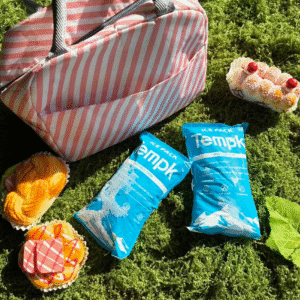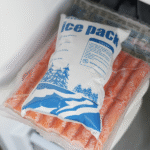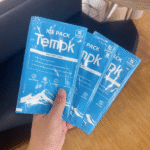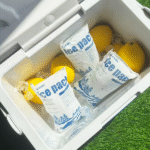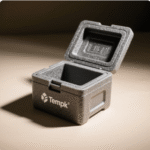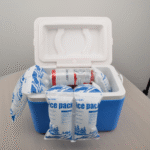Trockeneisbeutel können während des Transports anschwellen oder platzen, wenn CO₂-Gas eingeschlossen ist –Druckveränderungen allein sind nicht die Ursache. Ihr Ziel ist einfach: Lassen Sie das Gas raus, während Sie die Kälte drinnen lassen. Mit belüfteten Einsätzen, geplanter Kopfraum, und konforme Kennzeichnung, Sie verhindern Schwellungen, Schützen Sie die Handler, und halten Sie die Nutzlasten auf Straßen- und Flugrouten innerhalb der Spezifikationen.
-
Warum tun Trockeneisbeutel quellen auf oder platzen?
-
Sind Höhen- und Druckänderungen wichtig??
-
Wie viel Kopfraum ist „genug“??
-
Welches Design stoppt das Anschwellen??
-
Was sollte in Ihrer SOP stehen? 2025?
Warum quellen oder platzen Trockeneisbeutel beim Transport??
Trockeneisbeutel quellen auf oder platzen, wenn CO₂-Gas in einer versiegelten Auskleidung oder luftdichten Box eingeschlossen ist. Trockeneis untermauert (fest → gasförmig) wie es wärmer wird, und dieses Gas dehnt sein Volumen um das Hundertfache aus. Wenn es nicht entkommen kann, Die Folienballons und Nähte versagen.
Denken Sie an eine geschüttelte Limonadenflasche – der Sprudel will raus; Die Kappe entscheidet, ob es quillt oder spritzt. Ein mikroperforierter Beutel oder Ventilbeutel „bricht die Kappe auf“, sodass CO₂ sicher austreten kann. Fügen Sie einen bescheidenen Luftraum hinzu, damit die Pellets die Entlüftung nicht verstopfen. Dieser Ansatz funktioniert sowohl in heißen Transportern auf der letzten Meile als auch in Reiseflughöhe.
Wie viel Gas produzieren Trockeneisbeutel tatsächlich??
| Trockeneismasse | Ca. CO₂-Volumen (L) | Ca. CO₂-Volumen (m³) | Was es für Sie bedeutet |
|---|---|---|---|
| 0.25 kg | ~130 L | 0.13 m³ | Bei kleinen Kühlern ist ein sichtbarer Entlüftungspfad erforderlich |
| 0.5 kg | ~260 L | 0.26 m³ | Lassen Sie den Liner locker |
| 1.0 kg | ~520 L | 0.52 m³ | Kopfspace + Mikrobelüftungen verhindern ein Aufblähen |
| 2.5 kg | ~1.300 L | 1.30 m³ | In mehrere belüftete Beutel aufteilen |
| 5.0 kg | ~2.600 L | 2.60 m³ | Verwenden Sie technische Lüftungsöffnungen und eine starke Isolierung |
Lassen „Druckänderungen“ in Flugzeugen oder Bergen Trockeneisbeutel platzen??
Nicht, wenn Trockeneisbeutel belüftet sind. Unter Druck stehende Laderäume und Kabinen reduzieren den Umgebungsdruck, verursachen aber selbst keine Ausfälle. Was zählt, ist die Belüftung und der Kopfraum.
Luftfrachträume zielen auf Kabinenhöhen von etwa 6.000–8.000 Fuß ab. Auf Straßenspuren gibt es Temperaturschwankungen und Höhenunterschiede. In beiden, Es gilt das gleiche Prinzip – belüftete Trockeneisbeutel, sichtbare Entlüftungswege, bescheidener Kopfraum, und keine versiegelten Nähte am Deckel.
Kopfspace: Wie viel brauchen Trockeneisbeutel??
Zielen nach 15–25 % interner Luftraum. Das schützt Lüftungsschlitze, Absorbiert Frühgas, und verhindert den Druck des Deckels auf die Folie.
| Versandtyp | Headspace-Ziel | Warum funktioniert es | Für dich |
|---|---|---|---|
| Pharma-/Biotech-Luft | 20–25% | Berücksichtigt Höhe und Asphalthitze | Geringere Schwellung + konforme Entlüftung |
| Tiefkühlkost gemahlen | 15–20% | Gleicht Kälteleben und Gasfreisetzung aus | Weniger pralle Kartons |
| Langstreckenflug | 18–25% | Zusätzlicher Puffer für Spikes | Reibungslose Akzeptanz durch die Fluggesellschaft |
Welches Packungsdesign verhindert, dass Trockeneisbeutel platzen??
Wählen Sie einen belüfteten Liner, Halten Sie den Entlüftungsweg offen, und trennen Sie das Paket von der Nutzlast. Niemals in der Nähe von Trockeneis heißversiegeln. Halten Sie eine „Deckelzone“ ein, damit CO₂ aufsteigt und austritt.
Schritt-für-Schritt-Packout
-
Vor-Chill der Versender; Laden Sie zuerst die Nutzlast.
-
Wiegen Trockeneis; aufgeteilt in mehrere belüftete Trockeneisbeutel.
-
Schließen mit a falten und klemmen oder Ventil/Perf-Liner – keine Heißsiegel.
-
Shim für 15–25 % Kopfraum; Halten Sie die Lüftungsschlitze frei.
-
Etikett mit der UNO 1845 und Gewicht; Blockieren Sie nicht die Entlüftungswege.
Was soll Ihr 2025 SOP enthalten?
-
Belüfteter Liner erforderlich.
-
Headspace wird bei 15–25 % gehalten.
-
Gaskontrolle in der ersten Stunde in PQ-Protokollen.
-
Etiketten: Und 1845 + Nettogewicht.
-
Ausbildung: Das Personal erkennt Schwellungen frühzeitig.
Verwechseln Sie Trockeneisbeutel und Gelbeutel??
Gelpackungen kein Gas erzeugen. Trockeneisbeutel sind festes CO₂ und Muss entlüften. Wenn beide verwendet werden, Platzieren Sie das Gel in der Nähe des Produkts und das Trockeneis darüber, mit einem Polster, das die Lüftungsschlitze trennt.
2025 Trends bei drucksicheren Trockeneisbeuteln
Intelligente Entlüftungsmembranen, CO₂-Punkte, und hybride Kältemitteldesigns dominieren mittlerweile die Kühlkettenverpackung. Diese erhöhen die Sicherheit, Einhaltung, und Nachhaltigkeit bei gleichzeitiger Reduzierung der Nacharbeit.
Neueste Fortschritte auf einen Blick
-
Belüftete Beutel mit Klemmverschluss: konsistente Entlüftungsgeometrie
-
Headspace-Unterlegscheiben: Abstand automatisch einhalten
-
Co₂ -Sensoren: kostengünstige Indikatoren für Schulung und Qualitätssicherung
FAQ
Quellen oder platzen Trockeneisbeutel während des Transports aufgrund von Druckänderungen??
Nur wenn CO₂ eingeschlossen ist. Mit belüftetem Innenfutter und Kopfraum, Routinemäßige Druckänderungen führen nicht zu Luftstößen.
Wie viel Freiraum sollte ich über Trockeneisbeuteln lassen??
Halten Sie 15–25 % des Innenvolumens für Entlüftung und Expansion frei.
Was Schwellungen am schnellsten reduziert?
Wechseln Sie zu Ventil- oder perforierten Linern, Entlüftung freilegen, und teilen Sie große Beutel in kleinere, belüftete Beutel auf.
Benötige ich besondere Regeln für Flugzeuge??
Das Gleiche wie Boden: belüftete Liner, Kopfspace, und richtige Etiketten.
Zusammenfassung & Empfehlungen
Trockeneisbeutel platzen nur, wenn CO₂ eingeschlossen ist. Belüftete Liner verwenden, 15–25 % Kopfraum, und freiliegende Ventilwege. Fügen Sie eine Gasprüfung in der ersten Stunde hinzu, und teilen Sie große Ladungen in mehrere belüftete Pakete auf.
Nächste Schritte:
-
Führen Sie eine CO₂-Volumenprüfung durch.
-
Ersetzen Sie heißversiegelte Beutel durch belüftete Beutel.
-
Fügen Sie Unterlegscheiben für den Kopfraum hinzu.
-
Validieren Sie mit Probesendungen.
Über Tempk
Tempk bietet drucksichere Kühlkette Lösungen zum Temperaturausgleich, Sicherheit, und Akzeptanzgeschwindigkeit. Unsere belüfteten Trockeneisbeutel und Hybrid-PCM-Designs reduzieren Schwellungen und verlängern die Kältelebensdauer.
Bereit für einen sichereren Versand? Kontaktieren Sie unser Team für maßgeschneiderte Empfehlungen.






